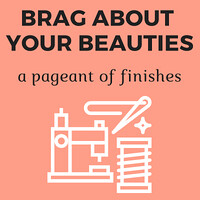Ninety-nine percent of the time, I piece my backs. My tried-and-true technique for doing so involves using stash and scraps and avoids matching repeats. Period. (For the nitty-gritty on my “recipe” for piecing a back like that, see this post.)
However, sometimes an especially beautiful fabric—often with a large-scale design—merits the extra effort to match a repeat. My most recent experience in matching two fabric widths was my most successful to date. Here’s the step-by-step process ...
1. Press both cuts of fabric well. For the record, I use an inexpensive iron and, as a regular course of action, do not use steam.
2. Determine where in the design to match up the repeat. Then fold one of the cuts of fabric along the length at that point, and press. The weave of fabric—and as a result, the design—tends to shift over time on a bolt. As a result, I let the design determine where I fold and press the fabric instead of, say, measuring from an edge to identify where to fold and press.
3. Lay the fabric on your ironing board. I’m right-handed and find it easiest to place the unfolded cut on the surface first. Then I lay the folded cut on top and to the right.
4. Place a little glue along the bottom of the fold. Line the design up with the other cut of fabric, and set the glue with an iron. A washable school glue (in a bottle or a stick) will do the job. I find that gluing and pressing 6 inches at a time works well.
5. Open up the fabric up, keeping the right sides of the cuts together, and sew directly on the fold. You could sew an initial pass with a longer stitch, see whether you like the results, and then, if everything looks good, resew over that original line of stitches with a shorter stitch length. I, however, just sewed along the fold once with my standard stitch length.
6. Press the joined widths. In general, I prefer to press any seams, and especially those on a quilt back, open, but I find it easiest to press to one side in this situation. If you’re patient and don’t overdo the glue, you could carefully pry the seam open for pressing.
7. Step back and admire your work! Any visible glue will disappear in the wash.
What is your approach to sewing pieced backs—do you match seams? Or do you avoid the issue altogether by using widebacks?!
More From Bolt to Beauty techniques ...
- How I Machine-Piece Hexagons
- How I Achieve Perfect Points Without Pins
- How I Bind My Quilts
- How I Piece My Backs
- How I Finger-Press to Save Time
Follow Me On ...
The pageant rules are simple:
- Post your finish in the linky tool. (No links to your own giveaway or linky, please!)
- Point your readers back here with a text link or use the button above.
- Visit and comment on other participants’ finishes.











I honestly haven't really attempted to pattern match, but this makes so much sense; thank you for the great tutorial!
ReplyDeleteHi,
ReplyDeleteI agree with Yvonne, makes total sense. Thanks
for sharing this info. Have a great day!
Thank you so much for showing how to pattern match the backing. It is always a challenge for me. Happy quilting.
ReplyDeleteI want to do it with one of my backings but haven't yet ;)
ReplyDeleteThanks for sharing your pattern matching technique and your handy tips.
ReplyDelete